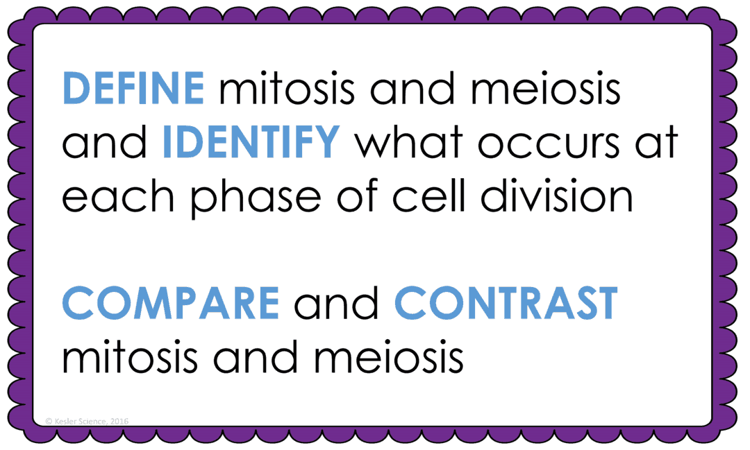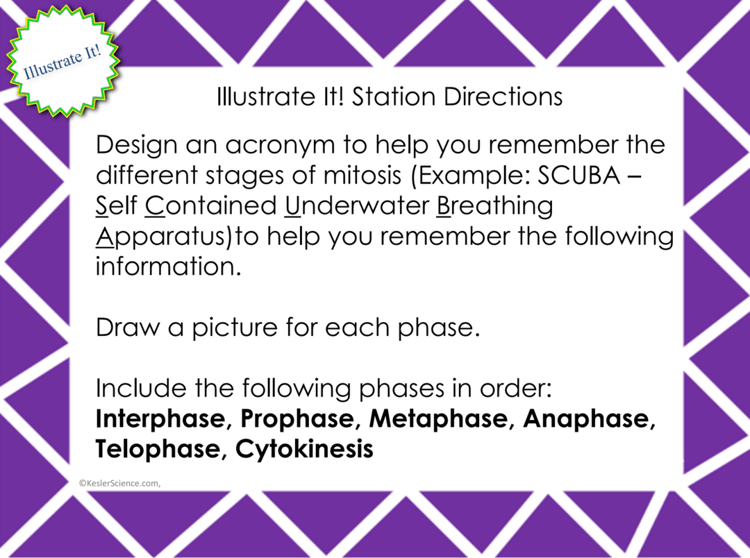MITOSIS AND MEIOSIS LESSON PLAN – A COMPLETE SCIENCE LESSON USING THE 5E METHOD OF INSTRUCTION
At the end of this mitosis and meiosis lesson plan, students will be able to define mitosis and meiosis and identify what occurs at each phase of cell division. Students will also be able to compare and contrast mitosis and meiosis. Each lesson is designed using the 5E method of instruction to ensure maximum comprehension by the students.
The following post will walk you through each of the steps and activities from the mitosis and meiosis lesson plan.
ENGAGEMENT
Objective Introduction
At the beginning of the lesson, the class will do a Think-Pair-Share to discuss the objective.
Class Activity
- Review the definition of a cell with students (Smallest structural and functional unit of an organism).
- Review the definition of a nucleus (membrane-enclosed organelle that contains the cell’s genetic information) and chromosome (a packaged and organized structure containing most of the DNA of a living organism).
- Tell students they are going to learn about two different types of cell division, but this activity only focuses on one (mitosis).
Student Activity
- Give pairs or groups of students a set of mitosis task cards (provided in the 5E lesson).
- Ask them to sequence the steps of mitosis. For special education students, you might want to start them with the interphase card.
- Let them work on this for awhile before you tell them the correct sequence.
- Talk through what is happening in each stage.
- Then give them the labels and define the prefixes for each stage. See if they can match the name of the stages.
- Inter – interphase means “between”
- Pro – prophase means “advance”
- Meta – metaphase means ” along with”
- Ana – anaphase means “up or apart”
- Telo – telophase means “final or distant”
- Tell students they will be learning more about mitosis as well as another kind of cell division called meiosis.

The teacher will help to clear any misconceptions about mitosis and meiosis. Students think all divided calls have the same genetic material as the parent cell.
Estimated Class Time for the Engagement: 20-30 minutes
EXPLORATION
This student-centered station lab is set up so students can begin to explore mitosis and meiosis. Four of the stations are considered input stations where students are learning new information about mitosis and meiosis and four of the stations are output stations where students will be demonstrating their mastery of the input stations. Each of the stations is differentiated to challenge students using a different learning style. You can read more about how I set up the station labs here.
EXPLORE IT!
Students will be working in pairs to better understand mitosis and meiosis. They will be using a series of cards illustrating the stages of cell division and the descriptions of each stage. Students will try to match up what card goes with the description card. They will follow the steps and record their observations on their lab sheet.
WATCH IT!
At this station, students will be watching a short video explaining mitosis and meiosis. Students will then answer questions related to the video and record their answers on their lab station sheet. For example: Write a true statement about cells after they go through the process of mitosis. How is meiosis different from mitosis? What are the two main types of cells and where are they found in the human body?
RESEARCH IT!
The research station will allow students to explore an interactive webpage which goes through the steps of mitosis and meiosis. Students will be instructed to complete a few tasks and record answers on their lab sheets.
READ IT!
This station will provide students with a one page reading about mitosis and meiosis. Students will get learn the differences between cell division, mitosis, and meiosis. There are 4 follow-up questions that the students will answer to show reading comprehension of the subject.
ASSESS IT!
The assess it station is where students will go to prove mastery over the concepts they learned in the lab. The questions are set up in a standardized format with multiple choice answers. Some questions include: Which stage of mitosis will come next? Describe what is happening in this stage of mitosis. How is meiosis different from mitosis? Which sequence best describes the correct order for mitosis?
WRITE IT!
Students who can answer open-ended questions about the lab truly understand the concepts that are being taught. At this station, the students will be answering three task cards: What is meiosis and where does it happen? Describe the vocabulary terms, interphase, prophase… How are mitosis and meiosis different?
ILLUSTRATE IT!
Your visual students will love this station. They will create a drawing for each stage of cell division and create an acronym to help remember each stage in order.

ORGANIZE IT!
The organize it station allows your students to lock in the terms used in this lesson with the correct definitions. Once students have completed their organization, the teacher will come and check their understanding.
Estimated Class Time for the Exploration: 1-2, 45 minute class periods
EXPLANATION
The explanation activities will become much more engaging for the class once they have completed the exploration station lab. During the explanation piece, the teacher will be clearing up any misconceptions about mitosis and meiosis with an interactive PowerPoint, anchor charts, and notes. The mitosis and meiosis lesson includes a PowerPoint with activities scattered throughout to keep the students engaged.
The students will also be interacting with their journals while taking notes from the PowerPoint. If you have students that need modified notes, the 5E lessons come equipped to help give every student access to the lesson.
Estimated Class Time for the Exploration: 2-3, 45 minute class periods
ELABORATION
The elaboration section of the 5E method of instruction is intended to give students choice on how they can prove mastery of the concept. When students are given choice the ‘buy-in’ is much greater than when the teacher tells them the project they will have to create. The elaboration project will allow students to create a number of different project ideas ranging from infographics to scrapbooks.
Estimated Class Time for the Elaboration: 2-3, 45 minute class periods (can also be used as an at-home project)
EVALUATION
The final piece of the 5E model is to evaluate student comprehension. Included in every 5E lesson is a homework assignment, assessment, and modified assessment. Research has shown that homework needs to be meaningful and applicable to real-world activities in order to be effective. When possible, I like to give open-ended assessments to truly gauge the student’s comprehension.
Estimated Class Time for the Elaboration: 1, 45 minute class period
DOWNLOAD THE FULL LESSON NOW
The full lesson is available for download from the Kesler Science Store. Save yourself a ton of time and grab it now.
Download Over $100 in FREE Resources
For Middle School Science
Simply create a login below and gain immediate access to a selection of our Kesler Science product line worth $100 - for FREE. There's a full version of every product type! You'll also join tens of thousands of middle school science teachers who receive timely tips and strategies straight to their inbox.






